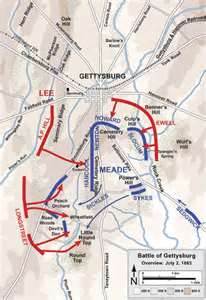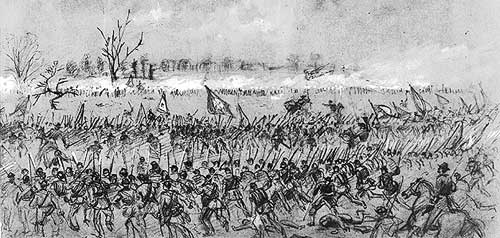The American Civil War
Part 6: Gettysburg Occurring at the same time in Pennsylvania was the Battle of Gettysburg. After the victory at Chancellorsville, Lee won approval for another invasion of the North. So much of the fighting during the past two years had taken place in the South that Lee, among other reasons, wanted some of the North to feel the brunt of a battle. A peace movement was growing in the North at this time, and Lee also hoped that a great Southern victory in the North would convince other countries, like Britain and France, to send aid to the South. The Army of Northern Virginia, 72,000 men strong, wended its way into the North, aiming to threaten large Northern cities like Baltimore, Philadelphia, and even Washington, D.C., itself. After the loss of Jackson, Lee had reorganized one corps of the army into two, with lieutenant-generals A.P. Hill and Richard Ewell gaining corps commands. Retaining command of the First Corps was Lt. Gen. James Longstreet, architect of the defensive strategy that had been so effective in previous battles, mainly at Fredericksburg. Leader of the cavalry division was Maj. Gen.J.E.B. Stuart, who had been a great help in the past by delivering to Lee precise information on enemy movements and strength. The Army of the Potomac, meanwhile, was still strong (at 94,000 men), still under the command of "Fighting Joe" Hooker, and still smarting from the defeat at Chancellorsville. The two large armies ran into each other by accident. The Confederate troops discovered a Union cavalry force under Brig. Gen. John Buford; neither side was looking for a fight at that time, so both withdrew. Buford's force was an advance force of the larger Union army, which Hill discovered when he sent an attack force numbering brigades the next day. Foreshadowing things to come, Buford's troops set up defense lines on three ridges west of town. Hooker and President Abraham Lincoln disagreed on how best to confront Lee's invasion force. The result was yet another new commander of the Army of the Potomac, George Gordon Meade. Meanwhile, Stuart and a large part of his cavalry division departed on a reconnaissance mission, to ride around the east flank of the Union army known to be in the area. Stuart's mission took several days to complete.
Stuart and his cavalry were not back at this time, and so Lee did not have an accurate accounting of the Union forces or their positions. Longstreet advised against an assault on what he thought to be a superior Union position. The defense-minded Longstreet preferred to have the enemy come to him. Still, Lee was confident in his troops and in their ability to overcome long odds, as they had done for two years. Lee decided to attack. Union defenders held their high ground in the face of a furious charges. On Little Round Top, the attackers nearly had their way. Finally turning the tide in favor of the Union was a bayonet charge ordered by Col. Joshua Chamberlain, the commander of the 20th Maine. Surprised Confederate troops ran back down the forested hill in full retreat. In the middle of the second day, Stuart and his cavalry arrived. They played no meaningful part in the day's fighting. On July 3, Lee ordered another attack on Culp's Hill. Before this attack could commence, however, Union artillery opened fire on the part of the hill they had lost. An infantry skirmish followed, and Union troops regained full possession of Culp's Hill, about 11 a.m. Seeing this, Lee decided on a direct frontal assault on the Union positions on Cemetery Ridge. After a massive artillery barrage on the Union position, Maj. Gen. Beaten and exhausted, Lee and his men left the North, never to return. |
|
Social Studies for Kids
copyright 2002–2025
David White



 More troops from both armies arrived throughout the night of July 1 and the early morning of July 2. Union troops seized control of other hills looking over the town, among them Culp's Hill, Little Round Top, and Seminary Ridge. Meade positioned his troops in a fishhook formation, anticipating that their positions on top of various hills and ridges would give them a good defensive position if attacked. Lee's forces, meanwhile, were arrayed in a wide arc surrounding the fishhook.
More troops from both armies arrived throughout the night of July 1 and the early morning of July 2. Union troops seized control of other hills looking over the town, among them Culp's Hill, Little Round Top, and Seminary Ridge. Meade positioned his troops in a fishhook formation, anticipating that their positions on top of various hills and ridges would give them a good defensive position if attacked. Lee's forces, meanwhile, were arrayed in a wide arc surrounding the fishhook. George Pickett
George Pickett
